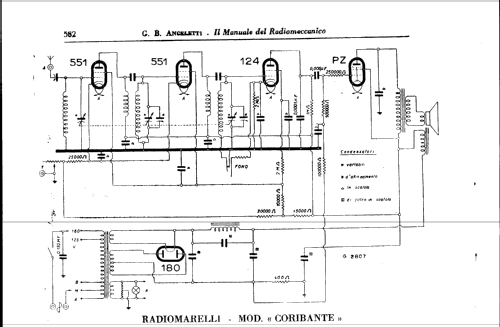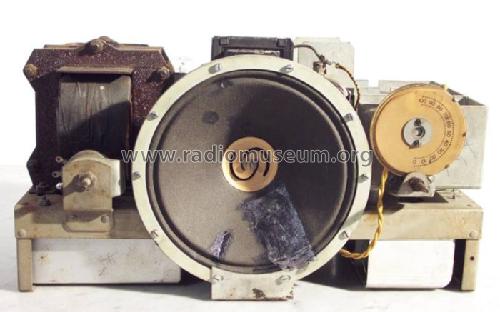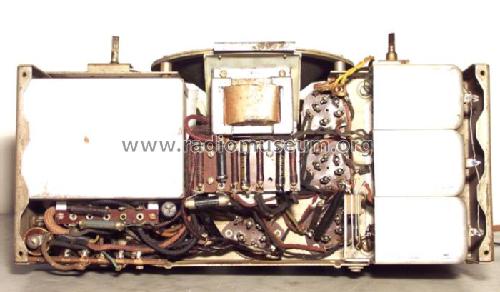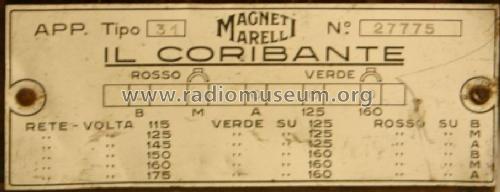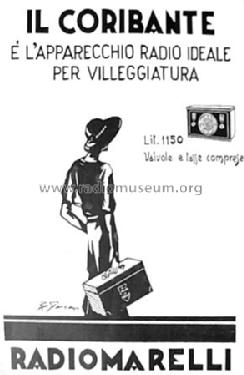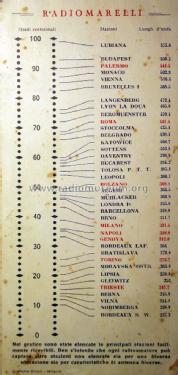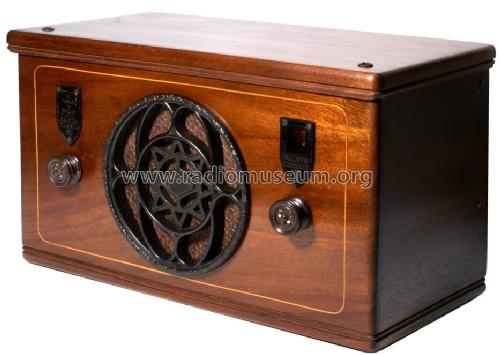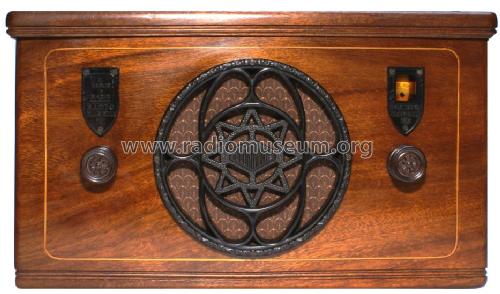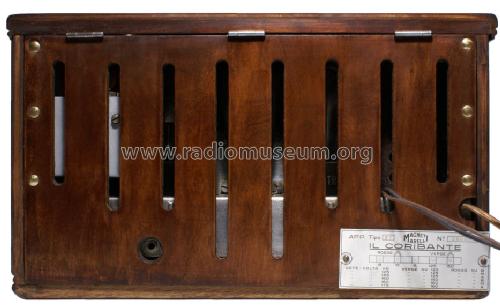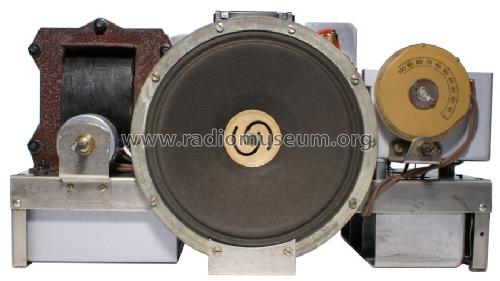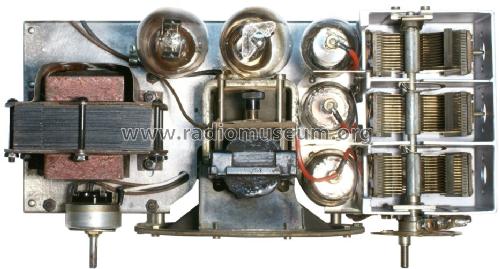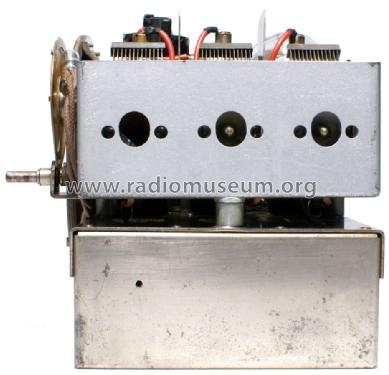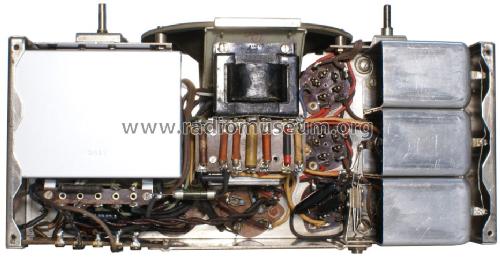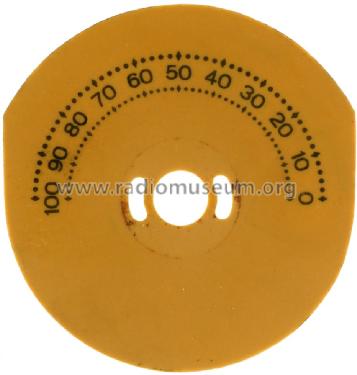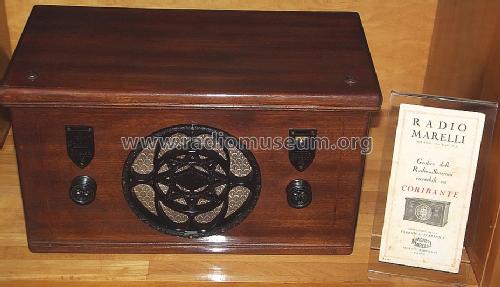- Country
- Italy
- Manufacturer / Brand
- Marelli (Radiomarelli); Sesto San Giovanni (MI)
- Year
- 1931/1932
- Category
- Broadcast Receiver - or past WW2 Tuner
- Radiomuseum.org ID
- 72483
Click on the schematic thumbnail to request the schematic as a free document.
- Number of Tubes
- 5
- Main principle
- TRF without regeneration; Screengrid 1926-1935
- Tuned circuits
- 3 AM circuit(s)
- Wave bands
- Broadcast only (MW).
- Power type and voltage
- Alternating Current supply (AC) / 126; 160 Volt
- Loudspeaker
- Electro Magnetic Dynamic LS (moving-coil with field excitation coil)
- Material
- Wooden case
- from Radiomuseum.org
- Model: Coribante - Marelli Radiomarelli; Sesto
- Shape
- Tablemodel, Box - most often with Lid (NOT slant panel).
- Dimensions (WHD)
- 400 x 210 x 230 mm / 15.7 x 8.3 x 9.1 inch
- Notes
-
In mogano. Derivante dall'American Bosch 5A.
Mahogany case. This set is based on American Bosch 5A.Ulteriore possibile variazione a 3 posizioni (B M A) della tensione di alimentazione.
- Net weight (2.2 lb = 1 kg)
- 13 kg / 28 lb 10.1 oz (28.634 lb)
- Price in first year of sale
- 1,150.00 ITL
- Source of data
- Guida Pratica Antique Radio II (2000)
- Mentioned in
- La moderna Supereterodina, Ravalico, 1938 (pag. 371)
- Literature/Schematics (1)
- -- Schematic (La Riparazione degli Apparecchi Radio, Delforno - Colciago, Italy 1941)
- Author
- Model page created by Alessandro De Poi. See "Data change" for further contributors.
- Other Models
-
Here you find 487 models, 378 with images and 300 with schematics for wireless sets etc. In French: TSF for Télégraphie sans fil.
All listed radios etc. from Marelli (Radiomarelli); Sesto San Giovanni (MI)
Collections
The model Coribante is part of the collections of the following members.
Museums
The model Coribante can be seen in the following museums.
Forum contributions about this model: Marelli Radiomarelli: Coribante
Threads: 2 | Posts: 4
The Coribante has been one of the first sets produced by Radiomarelli under license from American Bosch and its success was immediate. It was introduced on the Italian market in October 1931 and at the end of 1932 more than 10.000 sets had already been sold. The price was 1150 Italian lire (a good salary in those years) and it is interesting to observe that, by considering that 1 lira of 1932 is roughly equivalent to 1 Euro, its value has remained unchanged; in fact a set in good conditions has a market value that can reach 1000-1200 Euro.
The Coribante is usually considered as the Italian version of the American Bosch 5A. This is essentially true but with two exceptions concerning the power supply and the case; the Coribante is endowed with a more sophisticated power supply and with a fine solid mahogany case with a peculiar and appreciated look.
The circuit is a TRF relying on three tuned circuits; the five tubes are a pair of 35/51 (high frequency amplifiers), 24 (detector/low frequency preamplifier), 47 (final) and 80 (full wave rectifier).
Despite the very simple circuit, the complete restoring of the Coribante has been more challenging than that of other more complex sets. The following points describe possible problems and report also some information not available in the literature.
1) Beware of wrong information! The first step in restoration projects concerns, in general, the acquisition of every available information on the set to be restored. In the case of the Coribante not much is available and one of the two published diagrams (page 582 of "Il Manuale del Radiomeccanico") contains the errors reported in Figure 1.

Figure 1 – Some wrong values on a Coribante diagram
Fortunately the reported values are so far from true ones that it is impossible to be deceived. Another wrong datum can be found in the original documentation concerning the American Bosch 5A where 0.5 mA are given as plate current of the 24 and this is not compatible with the 100V drop on the 1 MΩ load present on the plate; the correct value is thus 0.1 mA. Other data are simply not available (e.g. the center tap resistance inserted on the filament supply, the values of the inter-stage coupling capacitors etc.). For these reasons I have dedicated some time to drawing a more complete and (hopefully) correct diagram, now loaded on the Radiomuseum.org site.
2) Problems derive, sometimes, from good intentions. The three-section tuning capacitor mounted on the American Bosch 5A (as well as on the 5, 205A, 210, 144A, 200A, 200B etc.) relied on a simple bended sheet frame and Radiomarelli tried to improve the design by producing a light alloy fusion frame that should have been endowed with better precision and rigidity. Unfortunately the selected alloy was a ZAMa (Zinc-Aluminum-Magnesium alloy) formulation that revealed a remarkable tendency to warpage with obvious consequences on the geometry of the capacitor surfaces. Despite the possibility of completely disassembling the capacitor and the availability of two screws to align the three stators, restoring this device can require a lot of patience and, often, also the insertion of suitable wedges to compensate the deformations. Some deformed surfaces are clearly visible in Figure 2 on the front of the frame.

Figure 2 – The tuning capacitor of the Coribante relies on a ZAMa frame with some tendency to warping
3) Inter-stage coupling. The inter-stage coupling is performed by means of a transformer with orthogonal windings and a coupling capacitor consisting of a small brass lamina inserted inside the primary winding and directly soldered to the grid side of the secondary winding (see Figure 3, taken from the site Le Radio di Sophie created by Leonardo Mureddu).

Figure 3 – The inter-stage coupling capacitor is integrated into the primary coil
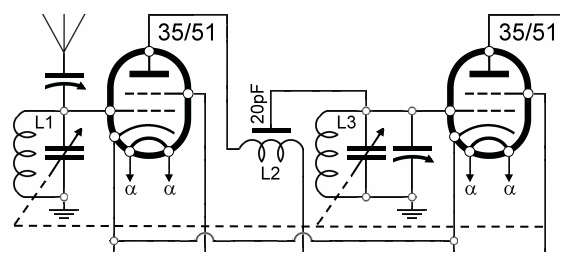
Figure 4 – Inter-stage coupling (a)
The inductance of the primary winding is approximately 0.3 µH while the inductance of the secondary winding is 210 µH. In some sets the lamina of the coupling capacitor has been cut in order to insert a serial capacitor to reduce the overall coupling. In other sets the original coupling capacitor has been completely excluded from the circuit and substituted with a traditional one (see the diagram in Figure 5).

Figure 5 – Inter-stage coupling (b)
When the original capacitor has not been excluded it would be better to avoid any change. It can be, however, advisable to check its leakage current that, because of the way it is constructed and of the absence of protecting compounds, could be abnormal despite its small value; in these cases its exclusion could be necessary to prevent future short circuits that would completely destroy the primary winding. In the sets where the original coupling capacitor has been isolated it is probably better to avoid its reconnection because the high temperature of the lamina during soldering could seriously damage the coil in which it is inserted. The value of this capacitor is not reported in the available diagrams of the Coribante or of the Americam Bosch 5A; the value that has been measured is 20 pF.
4) Virtual center tap on heaters supply. This circuit is realized by means of two resistors obtained with resistive wire wounded on the support shown in Figure 6 that is directly soldered on the socket of the 24.

Figure 6 – Heaters supply virtual center tab
This simple component must be carefully inspected not only to verify the integrity of the wire (badly repaired in the example reported in Figure 6) but also to verify the proper contact between the wire and the terminals, assured only by mechanical pressure. The value of these resistors is not reported in the available descriptions of the Coribante and it has been a surprise to measure the unusually low value of 2.7 Ω.
5) Volume control. The volume control acts on the polarization of the grid of the two 51 by modifying their cathode voltage from 2.5 V to approximately 40 V with a corresponding variation in the transconductance of more than 50 times. This solution is very effective and is implemented by means of a 10 KΩ wire potentiometer. It is not infrequent to find interrupted potentiometers that can be repaired by means of conductive silver paint as suggested in "Repairing_old_potentiometers". It is also possible to find substitutes constructed in the same period from Gary Schneider at "Play Things of Past” (more than 10.000 different types in stock!). It can be observed that also a 5 KΩ potentiometer allows a complete muting of the receiver.

Figure 7 – Volume control circuit
6) Power transformer. The maximal line voltage is limited to 160 V. It is however possible to increase by 15 V or to decrease by 10 V the settings (see Figure 8).

Figure 8 – Line voltage settings
The transformer is well dimensioned and should not require particular attention. The use of a plastifier is however advisable to improve isolation and to protect the inter-winding paper sheets from ambient moisture.

Figure 9 – The line transformer
7) Capacitor boxes and power supply design. Almost all capacitors are inside two metal boxes. The smallest one contains eight decoupling capacitors whose leakage current must be accurately checked at voltages not lower than the operating ones. Many points of view about the substitution of leaking paper capacitors have been expressed; situations like that shown in Figure 10 do not leave many options (a careful check has, however, been performed before proceeding to their substitution).

Figure 10 – Original capacitor box (the tar was no longer present) and restored one
The second large box contains the paper capacitors of the power supply. The code on this box, as well as equal or similar codes on other parts of the set, do not denote the part number but the construction date (in this case the code was 3111 = November 1931).

Figure 12 – Power supply capacitor box
The power supply diagram is reported in Figure 13. It deviates from the standard scheme implemented in the American Bosch 5a in that it uses, besides the field coil, a second inductor (L6 in Figure 13) with a parallel capacitor. This configuration could suggest an anti-resonant circuit tuned at the ripple frequency but this is not the case; a direct check has however shown that the parallel capacitor contributes to ripple reduction (the same scheme has been subsequently adopted in other Radiomarelli receivers like Musagete and Chiliofono).

Figure 13 – The Coribante power supply
The resistance of the field coil is 1880 Ω, that of L6 is 230 Ω. The resistance of the transformer high voltage winding is 380 Ω (each winding), the high voltage is 336 V (at no load). The design of the power supply and the low value of the resistances in the virtual center tap on the heaters supply lead to an exceptionally low and completely inaudible hum.
8) Alignment. Two sections of the tuning capacitor are endowed with trimmers that can be used to maximize the receiver gain at the upper end of the band. The external rotor plates could also be bended to align the receiver at intermediate frequencies but I would not suggest performing this operation because of the induced mechanical stress during bending. The original alignment of the scale can be deduced from a document by Radiomarelli that reports the names of some stations and the associate scale position.

Figure 14 – Scale frequencies
As can be seen in Figure 14, the Milano station corresponds to “40” while Bolzano to “50”. The frequencies of these stations in 1932 were 905 KHz and 815 KHz; we have thus the correct reference to align the scale. This operation can be done either by rotating the whole support of the scale with reference to the tuning capacitor axis or also (for small variations) by loosening two small screws that fasten the scale to its support.
9) Bandwidth. Measuring the frequency response of a TFR receiver can look fanciful and, in fact, it depends on both the tuned frequency and the transconductance of the tubes used in the first two stages that, as already said, depends on the position of the volume control. Despite its modest meaning, the frequency response has been measured at 560 KHz with the volume control set in order to have 4V on the cathodes of the two 51 (this voltage reaches 2.5V with the volume control turned completely clockwise). The input stage has been tuned to the same frequency as the other two stages by short-circuiting the antenna and ground fahnestock clips and by using the antenna trimmer to perform the tuning; the input signal has then been injected directly on the grid of the first 51 by means of a 5 pF capacitor. This precaution is necessary to avoid measuring an asymmetric curve due to the higher frequency on which the input stage is usually tuned. The response, normalized with respect to the center frequency, is compared in Figure 15 with the responses of the Magnadyne SV3 associated to maximal and minimal selectivity settings. It can be observed that the Coribante, in the adopted test setup, is very selective.

Figure 15 – Normalized Coribante bandwidth at 560 KHz (red) compared with the bandwidth of the Magnadyne SV3 at maximum (green) and minimum (blue) selectivity settings
In normal operating conditions the input stage is tuned at a slightly higher frequency and the frequency response becomes asymmetric as shown in Figure 16.

Figure 16 – Coribante bandwidth with the input circuit exactly aligned with the other two stages (red) and in normal operating conditions (blue)
10) Subjective evaluation of the receiver performance. The receiver exhibits a remarkable sensitivity (it can receive, by night, many stations with just the 40 cm of wire that connect the input trimmer to the fahnestock clip) and is completely hum-free. The audio power is exuberant, the audio quality more than acceptable. No selectivity problems have been observed.

Figure 17 – The restored Coribante

Figure 18 – The restored Coribante (open cover)
Roberto Guidorzi, 03.Jun.13
salve, in alcuni modelli del coribante ho visto esserci sopra le valvole una copertura metallica con una scritta. Vorrei sapere se l'avevano tutti i modelli o alcuni ne erano sprovvisti.
Franco Forlani, 02.Jan.19
